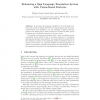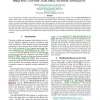28 search results - page 4 / 6 » Automatic Recognition of Colloquial Australian Sign Language |
FGR
2008
IEEE
14 years 2 months ago
2008
IEEE
In this paper, we investigate the mutual-complementary functionality of accelerometer (ACC) and electromyogram (EMG) for recognizing seven word-level sign vocabularies in German S...
GW
2007
Springer
14 years 1 months ago
2007
Springer
Abstract. In automatic sign language translation, one of the main problems is the usage of spatial information in sign language and its proper representation and translation, e.g. ...
LREC
2008
13 years 9 months ago
2008
A new, linguistically annotated, video database for automatic sign language recognition is presented. The new RWTH-BOSTON-400 corpus, which consists of 843 sentences, several spea...
FGR
2006
IEEE
14 years 1 months ago
2006
IEEE
We present a novel tracking algorithm that uses dynamic programming to determine the path of target objects and that is able to track an arbitrary number of different objects. The...
CVPR
2009
IEEE
15 years 2 months ago
2009
IEEE
Recognition of signs in sentences requires a training
set constructed out of signs found in continuous sentences.
Currently, this is done manually, which is a tedious process.
I...


